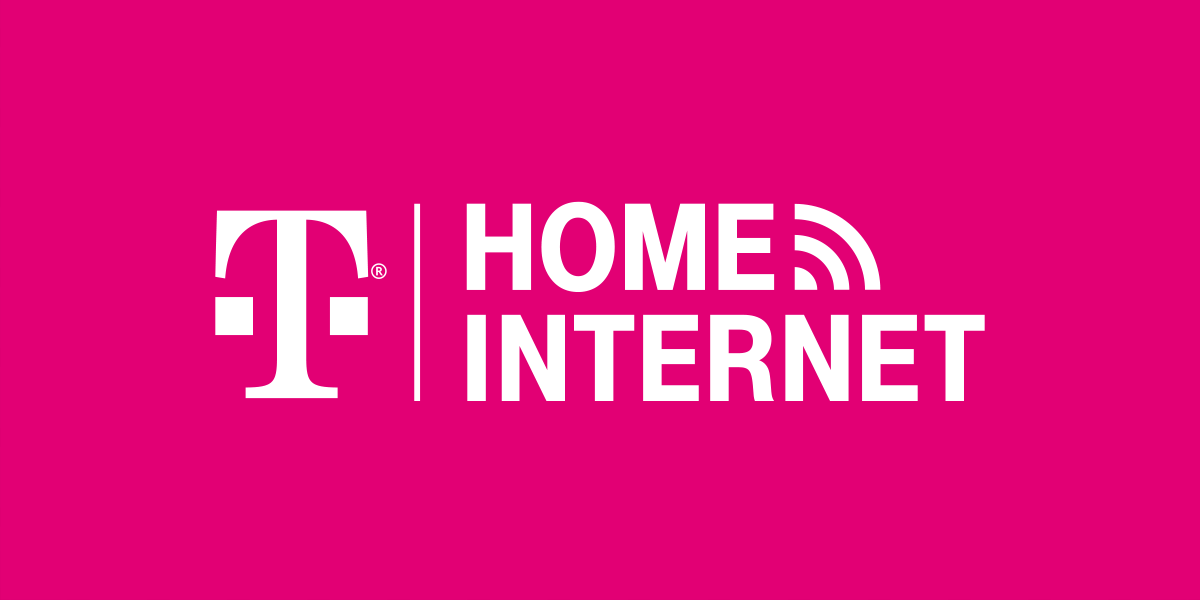WHAT IS IT?
Ditch the cable and the need for an ethernet cable! T-Mobile Home Internet uses their award-winning cell phone towers to deliver 5G internet straight to your home, for one low monthly price, without data caps or throttling, and without rate increases. Hmm…sounds too good to be true, doesn’t it?
INTERFACE/NAVIGATION
First things first, after signing up you will be sent a “gateway”, which is a weird, almost cone-shaped device that you use to access the Internet. Unlike traditional broadband services, where you can use your own modem and/or routers, you’re stuck using T-Mobile’s bizarre device. People frequently refer to it as a “trash can” on message boards, and it’s not an unfitting comparison. I would argue that it kind of looks “modern”, but it’s not something that’s going to fit the aesthetic of many homes.
Once you receive the gateway, you must download the T-Mobile Internet app. This will take care of setting things up for the first time. All of the options run along the bottom of the main app screen, and are pretty self-explanatory: You can see which devices are connected (and add/remove them accordingly), find the strongest signal for maximum performance, and a few more things that the average user won’t ever need.

The app is pretty straightforward, so most people shouldn’t have any issues navigating their way around.
EASE OF USE
Initial setup is supposed to be easy, although I must confess that I ran into quite a few problems. Typical broadband internet connects to a computer, via an ethernet cable, and then is spread throughout the area via a router. That ensures that any area around the computer should have a strong signal, with it dissipating the farther away things are. Since T-Mobile’s internet works via 5G technology (the same technology that’s used for phone data), there are no routers. That means proper placement of the gateway is imperative for the whole operation to work. If you put it in an area with a weak signal, your entire house will have weak internet.
I’d liken the experience akin to setting up a TV antenna, where you kind of have to guess and check placements until you get desired results. The documentation recommends placing it near a window, and in a spot that’s far away from appliances and other devices that can interfere with its signal, such as microwaves, cordless phones, etc. I figured it would just be a matter of putting it in the middle of the house and calling it a day, but it definitely wasn’t that easy.

It took me four tries to finally set it up somewhere that the gateway finally accepted. That might not sound as frustrating as it was, but you can’t move on with the setup process until you get a strong enough signal for the stupid device to “accept”. I was not aware of this, and much of those four attempts (or at least thirty minutes) were spent thinking I got a defective internet service.
Once we got it up and running, we haven’t had many issues since.
One thing worth noting, which should be a good thing for most people: There is nothing to install. I mean, the gateway, yeah, but there are no special wiring or installation requirements to use the service. Gone are the days of having a tech come out to run wires and charge you a bunch of money just so you can start using a specific service. In fact, “tech installation” isn’t even an option. About the only person this should affect negatively are older people too set in their ways to try something new. Even those with no tech savvy should be able to get it up and running within the hour.
RELIABILITY
Well, here’s where we find out whether or not the service delivers. What can one expect from one of the first 5G internet providers in the country?
This is far and away better than what we had with Spectrum, who raised the initial $49.99 signup price to a whopping $75 a few months after the promo price ended. We always had minor fluctuations with their internet service; not really enough to cancel or complain about it, but enough to be relatively annoying (about one or two instances where we’d need to reset the modem every month). With T-Mobile’s Home Internet, the blips are still there (which is natural for any ISP in a crowded area), but even less frequent. We’ve probably lost the internet for 20 total minutes a month, on average. And of those times, we’ve only had to reset the modem twice. In a year.

Now, unlike other ISP’s, T-Mobile doesn’t “guarantee”, or even specify the speeds you can expect to get. That was the main red flag that initially made me hesitant to sign up. But I figured if it sucked, I could just cancel after a month and go back to Spectrum’s $49.99 price as a “new customer”. (Goddamn, what a retarded industry standard.)
Once again, I was pleasantly surprised. With Spectrum, our steadily-increasing $75/month got us 200 Mbps speeds, and that was after the company “doubled” it for all current subscribers (so we were getting 100 when we signed up). Usually, when a company claims you get a certain speed, it’s usually a few Mbps lower, based on congestion and other constant factors. However, despite making no claims whatsoever, T-Mobile’s speeds have never dipped below 200 Mbps for us, frequently hitting 400 Mbps or more every time I’ve checked. Getting twice the speeds for $25/month less? I would consider that a win/win.
One possible concern is “throttling”, or the intentional slowing down of internet speeds once consumers hit a certain amount of data per month. Most ISP’s don’t actually do this, but they reserve the right to in order to help eliminate congestion. T-Mobile states nothing about throttling in their terms, which is nice. But, they do reserve the right to “deprioritize” internet users in moments of high congestion, which is a different term with basically the same end result. Again, we’ve never experienced it personally, but you don’t have to search the internet very far to find people who have.
HOW MUCH DOES IT COST?
Here’s where all the minor annoyances promise to at least be partially offset: T-Mobile’s Home Internet service is $50/month (with autopay; $55/month without). While that might sound a little pricey, especially since there are no initial deals for first-time customers like most cable-based ISP’s, their main selling point is that there are no annual contracts, and no price hikes. That’s right, gone are the days of getting a great deal for one or two years, and then seeing your costs double after the term ends, with no recourse to lower your bill short of switching carriers for a month or two, then re-signing up. (I’ve never understood any business model that punishes loyal customers – if anything, I’d respect an ISP that charged more for the first year, and then lowered the payment every month, or year, you stayed a subscriber.)

It’s also nice that the $50 price includes the gateway and taxes, so $50 is literally the exact price you pay. Considering some ISP’s charge upwards of $10 per month to use their modems, or add surprise taxes and/or fees, it’s kind of refreshing that T-Mobile doesn’t do that here. (I guess the downside is that, whereas other ISP’s let you use your own modem to avoid the extra monthly fee for using theirs, you’re forced into using T-Mobile’s limited gateway.)
AVAILABILITY
You would think T-Mobile Home Internet would be available anywhere they have cell service. Like most logical statements involving a large corporation, you would be wrong. According to Broadband now, T-Mobile’s internet service typically reaches between 50-60% of any given state’s population. That’s a far cry from the “99% coverage” they like to tout for their mobile coverage area.
IS IT WORTH THE COST?
What’s the catch, you may be wondering? Rightfully so. After all, it’s not just ISP’s and cable companies that are known for screwing people over: Cell phone companies are also notorious for it. And when you have a carrier that’s also dipping their foot into the internet business, well it feels like you could be on the receiving end of a double whammy.
There are certainly some caveats to using this service, the main one being that your internet service is prone to massive fluctuations in speed. Unlike cable connections, which should be pretty steady for the most part (outside of minor fluctuations during busy times), T-Mobile doesn’t guarantee you any set speed. That means you may get 300Mbps download speeds one moment, and then 100Mbps (or less) a short while later.

And while T-Mobile doesn’t “throttle” (reduce) speeds for internet consumers who go over a certain data amount per month, they do reserve the right to “deprioritize” their internet traffic during peak times. That means if the network gets congested, T-Mobile will prioritize cell phone users over internet customers. That can bring about reduced internet speeds during times of heavy use if you’re in a well-populated city. (For the record, we are in the suburbs of a major city, and have noticed no reduced speeds at all.)
To help combat this possibility, T-Mobile supposedly limits the number of people per area that can access their internet service. In other words, it could technically be available in a neighborhood, but if there are too many customers already, they wouldn’t allow anyone new to sign up. I’m not sure how often this happens (or honestly, if at all), but it’s something worth keeping in mind.
It’s also worth noting that T-Mobile doesn’t lure you in with promotional pricing that gets doubled (or tripled) after your first year is up. That can be a good or bad thing depending on personal preference. On the one hand, if you don’t mind calling and negotiating a new contract (or switching between service providers) every year, you could probably save even more over T-Mobile. On the other hand, for people who hate interacting with their ISP, T-Mobile’s internet offers a nice “set it and forget it” philosophy.
SUPPORT
In terms of customer service support, I have not yet had to use it, although I feel like everyone using a major carrier has to at some point. If it ever comes to that, I’m sure I will have some problems as people across the Internet have complained about long wait times. I guess that’s just par for the course when you’re using any popular company.
If you have an issue that can be self-serviced, you can post a question to the T-Mobile forums, where either another member, or a T-Mobile employee, will answer your question. That saves you potential wait times, assuming anyone is available to respond. It seems like, for the most part, users are quick to answer.
In other words, although I’ve never used their, I’d expect support to be the same hit-or-miss venture that it is with any large corporation.
OVERALL
PROS (+)
+Set price ($50) per month including taxes and fees, and with no rising costs
+Required gateway included at no additional monthly cost
+No upfront “activation” costs
+No need for a computer, or ethernet cables
+No hard data caps or throttling
CONS (-)
-Gateway is kind of an eyesore
-Subject to severe deprioritization during peak times
-Initial setup can be a little frustrating
-The quoted $50 per month price assumes autopay (though it’s just $5 more without)
-No initial discounts or deals for first year of service like most internet providers
-Speeds can fluctuate wildly
-Must use their (limited) gateway
We took a huge gamble going with T-Mobile Home Internet, after hearing some real spotty things about it. We live in a suburban area, right on the border of a huge metropolitan city, and somehow have very few internet options (WOW/Breezeway, Spectrum, and a very limited version of AT&T internet). I was hopeful, but more than a little skeptical that this could deliver what it promised. We figured if it sucked, we could just go back to Spectrum after a month to get their “new customer” discount (what a retarded industry standard).
But after a whole year, I can say that it has far exceeded our expectations. We were paying $75 per month for Spectrum’s 200 Mbps plan; with T-Mobile, we’re getting double that for $25 per month less. We’ve used over 500 GB of data virtually every month, and haven’t seen any drops in service or speeds – every time I’ve tested it, it’s been over 200 Mbps. There is the occasional network hiccup, where service will go out for five minutes or less, but these issues occur very rarely, and tend to fix themselves. This is a welcome change from Spectrum, where virtually any hiccup would require us to reset the router and modem.
Unfortunately, while we’ve had great results, YMMV. First of all, T-Mobile’s Home Internet is deprioritized even below MVNO customers (i.e. people using the T-Mobile network through resellers like Tello and Mint Mobile), meaning it’s the lowest priority service that they offer. To put it bluntly, if the network in your area is congested, your internet will be the first service to take a hit. Supposedly, they try to limit the number of Home Internet users in each area to prevent this from happening. But there’s no way to predict just how many people will be using their network at any given time, especially in large cities. Because of this, internet speeds can fluctuate wildly, with no expected range given by T-Mobile.
Like anything else, it all comes down to personal preference and results. We have very few options, so T-Mobile was a breath of fresh air for us. And the performance has been uniformly better than any ISP we’ve ever had. If it’s offered in your area, you might as well check it out. I’m not sure if 5G is the future of home internet, but chances are it’s no worse than any of your other options. And for probably less than you’re currently paying.
OVERALL: 8.5/10




It was kind of touched on in this review that you basically stuck using their Wi-Fi and it only has two Ethernet jacks. I took one home assuming that you could shut off the Wi-Fi in the unit and the salesperson Thought you could but it turns out you can’t. I have a brand new top of the line Wi-Fi router that I have all my devices paired to including a video doorbell that’s not easy to program. I was hoping the plug in my router then go into the settings and shut off the Wi-Fi but there is no setting to shut off the Wi-Fi and I did call them and they said well you can hide the SSID but that doesn’t shut off the radio that’s going to be interfering with my router. So I guess I’m stuck with Xfinity until they smarten up!
All that stuff is over my head (I just wanted internet, lol) but it seemed to be a dealbreaker for a lot of other people, too. I don’t understand the point of them doing that as they’re clearly alienating a large portion of their potential customer base. At the same time, it doesn’t seem like their internet service is really a focal point of their overall business plan, so they probably don’t care. Makes you wonder why they even offer it in the first place.